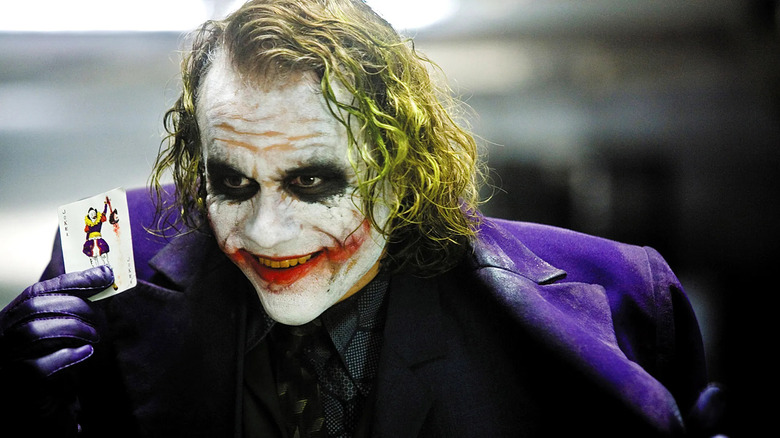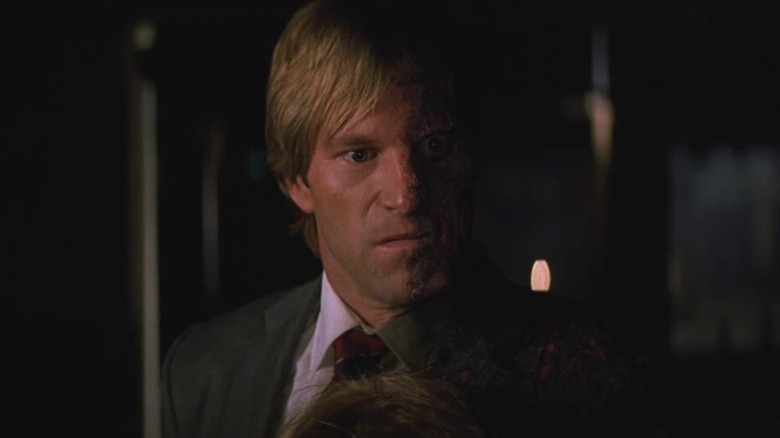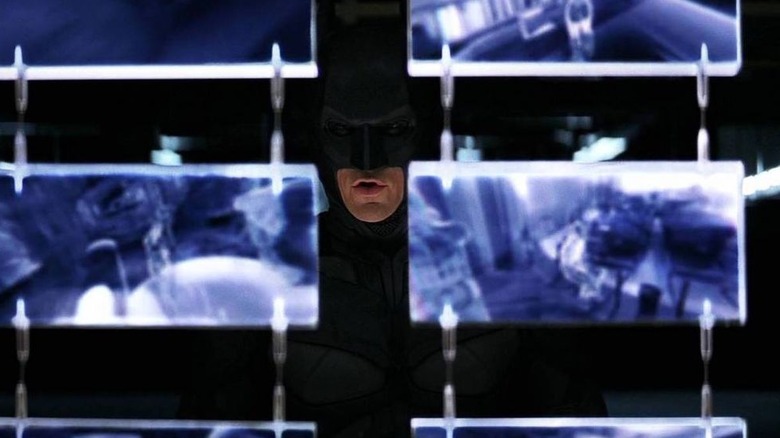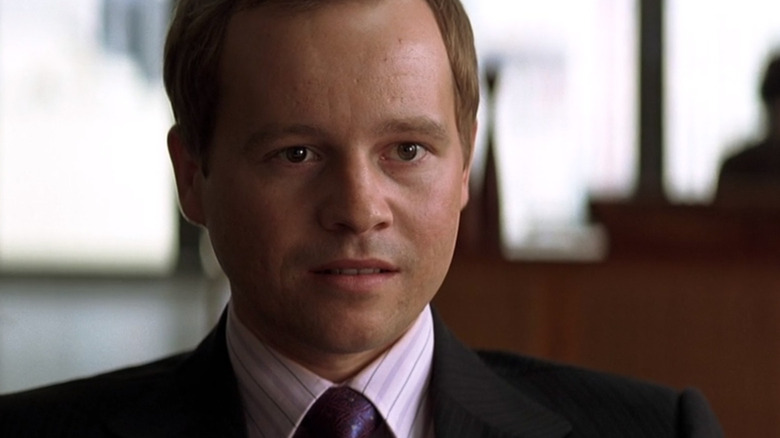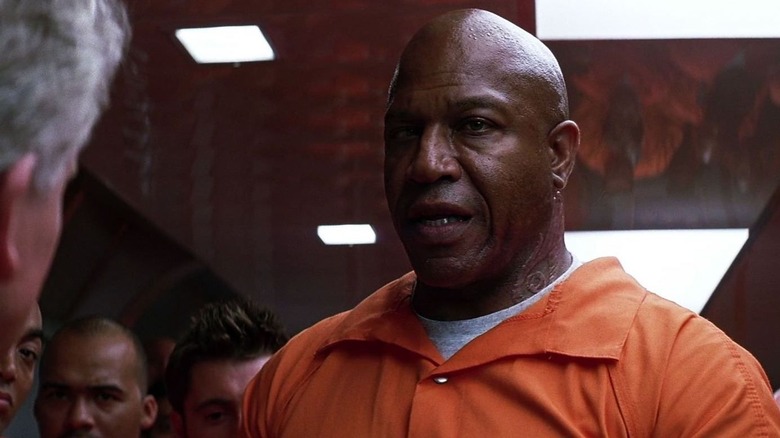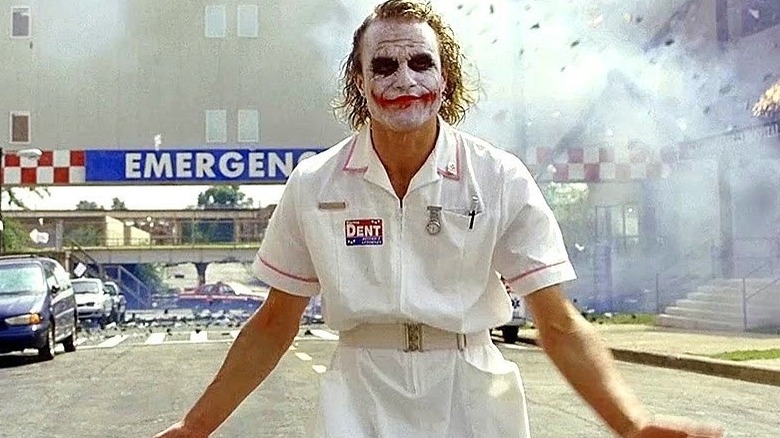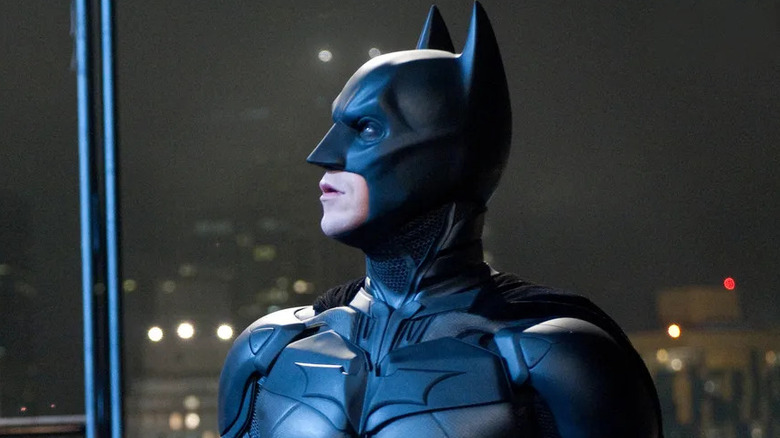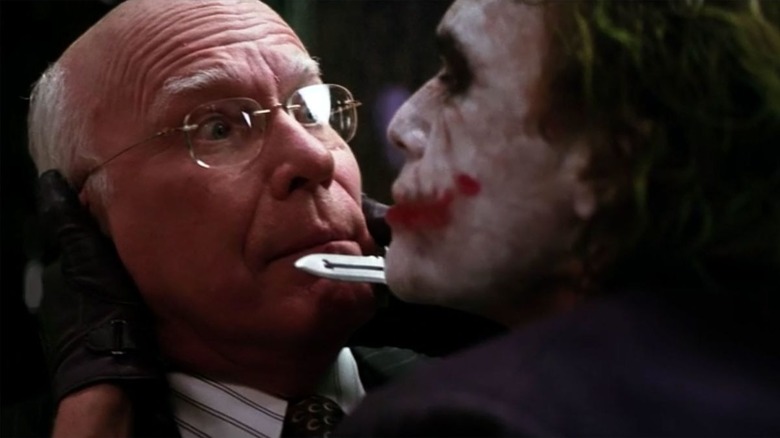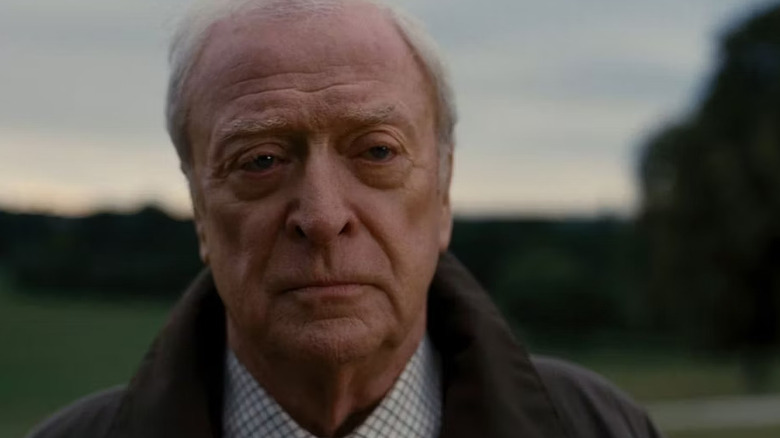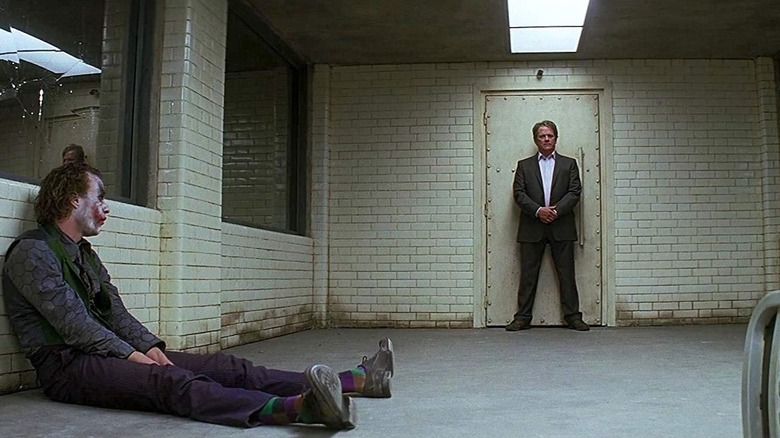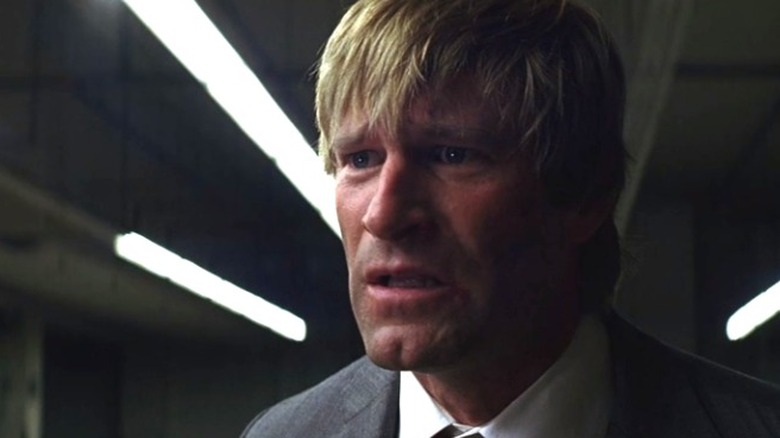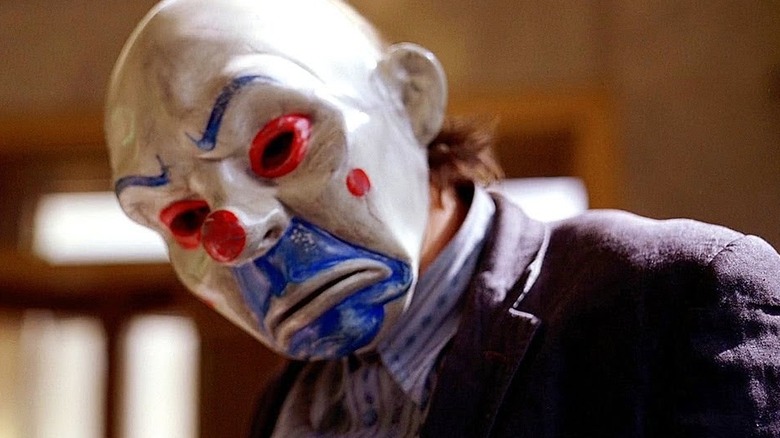The Dark Knight Scenes That Mean More Than You Think
Batman originated in the pages of comics with Detective Comics #27 in 1939 (via DC Comics). However, not long after that, the caped crusader would make his leap to the screen with two serials: "Batman" in 1943 and "Batman and Robin" in 1949. In fact, the '60s "Batman" TV series starring Adam West, which ran from 1966 to 1968, was a direct parody of those serials (via Den of Geek).
Now, the '60s "BAM" and "POW" version of Batman — despite possibly being similar to the comics of that particular era (via The Nerdist) — was not something many long-time fans wanted from the character. Luckily, the success of Frank Miller's influential 1986 graphic novel, "The Dark Knight Returns," led to a darker, grittier Batman film in 1989, directed by Tim Burton (via The Washington Post).
However, Batman films got campier under the direction of Joel Schumacher and a massive reboot came in 2005 with Christopher Nolan's hugely successful "Batman Begins" (via Box-Office Mojo). Of course, the critical and commercial success – as well as the teasing of the Joker at the end — led to a sequel not long after with 2008's "The Dark Knight," casting Heath Ledger as the aforementioned Clown Prince of Crime. And, like Nolan's other films, there are a lot of layers to it, even on a scene-to-scene basis. Whether it's re-interpreting old villains or relishing in philosophical debates, some scenes in "The Dark Knight" aren't what they initially seem on the surface.
Justifying war on terror
"The Dark Knight" came out in 2008, and though it may feel evergreen, the world was very much in a different place, culturally, socially, and especially politically in the mid-2000s. This was the era of color-coded terrorist threat alerts, an all-out war in Iraq, and a drastic increase in anti-Muslim sentiment which is still being felt today (via ABC News).
Because of this, Hollywood attempted to grapple with the nascent "War on Terror" in blockbuster entertainment. While the Joker is not coded as one, he is still arguably being used as a stand-in for a terrorist who needs to be brought to justice through extrajudicial means. This includes violating other nations' extradition laws, such as how Batman (Christian Bale) captures the corrupt Chinese money launderer Lau (Chin Han) in Hong Kong.
Furthermore, the heroes decide to lie about Harvey Dent's (Aaron Eckhart) transformation from law enforcer to murderous criminal to eventually (as we'll see in "The Dark Knight Rises") imposing draconian crime laws. Essentially, it is arguing that results are more important than the truth and that the ends justify the means.
Comment on increasing surveillance state in the US
Furthering the uncomfortable apologia for the early-'00s' War on Terror through popular media leads us to one of the most controversial plot points — especially in hindsight — which is Batman feeling like he's forced to use surveillance equipment around Gotham City to catch Joker before the villain kills a bunch of hostages. Batman had funded a secret program with the ability to spy on every single cellphone in the city to pinpoint Joker's exact location. Meanwhile, Batman's tech guy, Lucius Fox (Morgan Freeman), is reasonably upset and uncomfortable about the implications of the supposed hero's new gadget.
Luckily for Fox, Batman is a fictional character, and nobly blows up his high-tech and intrusive surveillance machine once Joker is finally apprehended. However, in reality, these gross violations against people's civil liberties have led to gross misuse, and have been aimed at progressive or marginalized populations, rather than thwarting terrorist plots (via civilrights.org).
Worse, this point can again arguably be seen as Nolan using the film's story to justify the War on Terror, as it demonstrably depicts this gross invasion of people's civil liberties as necessary and just, when in fact it's been shown that the Patriot Act and other far-reaching surveillance measures have had a negligible — if not outright negative — impact on counter-terrorism operations, due to focusing on the wrong communities and threats (via Center for Strategic and International Studies), among other issues.
Mr. Reese is The Dark Knight's version of The Riddler
Every Nolan-era Batman film has many baddies in them — proving that multiple villains aren't a problem, but rather the narrative's utilization of them. For instance, "Batman Begins" includes The Scarecrow (Cillian Murphy), Ra's al Ghul (Liam Neeson), and Victor Zsasz (Tim Booth). "The Dark Knight" is no different, with two iconic villain performances from Ledger as the Joker (which earned him a well-earned posthumous Oscar), and Eckhart as Two-Face.
However, there's a sneaky third villain hiding in plain sight in "The Dark Knight" – the nebbish Wayne Enterprise accountant, Coleman Reese (Joshua Harto). Mr. Reese eventually discovers that Bruce Wayne is Batman due to the discrepancies in Wayne's financial accounts and attempts to blackmail him. Now, it might seem like a stretch at first to say that Mr. Reese is actually the Nolanverse-version of The Riddler, but there are a lot of subtle clues that hint at his true identity.
For one, there's his look. He has pale skin and red hair, similar to pretty much all modern incarnations of The Riddler in comics, cartoons, and films (including 1995's "Batman Forever" and 2022's "The Batman"). Even his business suit has an (admittedly slight) green tinge, though his tie is unmistakably purple — both the signature colors of The Riddler. His name, though not Edward Nigma, has a similar portmanteau with "Mr. Reese" sounding like a similarly comic-book-y "Mysteries." He also discovers Batman's true identity, like in the comics.
Recreation of famous trolley problem in finale
While "The Trolley Problem" is probably most likely known to most modern readers as a funny oft-reiterated-on meme (via Know Your Meme), it is actually a well-known, and well-regarded, philosophical hypothetical focusing on ethics and individual morality. "The Trolley Problem" itself proposes that there is a runaway train going in one direction on a crash course towards a group of people, and a separate track with only one person on it. However, unfortunately, to stop the runaway train from running over the larger group and into one person instead — thus saving a larger number of people — you would have to actively pull the lever yourself, making you ultimately complicit.
So, with that knowledge, it's obvious to see that the Joker's final dastardly plan in the finale of "The Dark Knight" is a variation of this. However, instead of trains, it's two large ferries, and instead of two railroad routes, the Joker has given the hostages in each of the ferries a choice to either blow up the other ferry and save themselves, and if neither does, everyone dies.
This is all a culmination of the main battle that Joker and Batman have had throughout the whole film, as the hero and villain are essentially fighting for the soul of Gotham — Joker believing everyone is as nihilistic and malicious as he is, and Batman believing that the citizens of the city are mostly good and deserve to be saved and protected.
Purposeful distortion of anarchist theory
Joker has been described as an "anarchist" by many due to his adherence to a "chaos for chaos' sake" mentality throughout the film (via Polygon). This is most clearly exemplified in the hospital scene where Joker and Two-Face meet for the first time. However, this is a flawed and narrow — as well as borderline ahistorical — definition of anarchism. That's because anarchism is not a synonym for "chaos," but rather a legitimate political position, with the film conflating those definitions to arguably push a conservative worldview of "order above all else (i.e. Batman) is good."
Anarchism, as a political philosophy, is described by the Stanford Encyclopedia of Philosophy as a "political theory that is skeptical of the justification of authority and power" and "is usually grounded in moral claims about the importance of individual liberty, often conceived as freedom from domination...offer[ing] a positive theory of human flourishing, based upon an ideal of equality, community, and non-coercive consensus building."
Obviously, there are a lot of different facets of anarchism, but one of the most important parts is that it is about horizontal organization, rather than vertical hierarchy. This means, in essence, a dissolution of wealth inequality, as well as the disposal of rulers such as kings, presidents, or CEOs. Basically, "no gods, no masters." Whether or not that seems palatable or doable as a form of societal organization is irrelevant; the point is that there is more to the philosophy than simply chaos and nihilism.
Batman turning head is a metatextual reference to movie costume
The '60s action-adventure "Batman" series, while popular, had a similar costuming aesthetic as the '40s serials it was initially parodying — skin-tight spandex and cheap materials. Sure, West's costume was sleeker, shinier, and, unlike the serials, in color, but it wouldn't exactly strike fear in the hearts of criminals. That all changed when Burton took over as director of the big-budget '89 film, this time hiring Bob Ringwood (who had previously worked David Lynch's 1984 "Dune") as the costume designer for the film (via IMDb).
However, despite Ringwood creating a striking and unique design for the caped crusader, one of the issues with the costume was the inability of the actor to turn their head in since the neck was unarticulated. Michael Keaton, who played Batman in Burton's films, has said in interviews that the immovable cowl was extremely uncomfortable and claustrophobic to wear — necessitating the '90s Batman's iconic shoulder turn (via The Hollywood Reporter).
Even Nolan's first foray, 2005's "Batman Begins," forced Bale into the same type of immobile mask. Luckily, a few years later in "The Dark Knight," they wrote a plot point that let Batman finally turn his head left-to-right, with Bale's Wayne quipping, "it'll make it easier to back up out of the drive-way" when proposing the change to Fox.
The party guest Joker threatens is a real Senator
Joker is on screen for just over 30 minutes (via Showbiz CheatSheet) in "The Dark Knight." However, Ledger and the film make the most out of the limited screen time, which includes him and his clown-masked goons crashing Dent's fundraiser, hosted at Wayne's penthouse. The villain of course menaces a few of the guests, which includes an older bald gentleman who stands up to the Clown Prince of Crime ... right before Joker puts a knife to the guest's face.
But that guest isn't just a random extra or mid-range actor from central casting; it is former Vermont Senator Patrick Leahy (via CNN), who was in office from 1975 to 2023 and is a known avid Batman and general comic book fan. Not only has Leahy appeared in "The Dark Knight", but the politician has also been in other Batman films as well — five in total — including getting blown up by Lex Luthor in 2016's "Batman v Superman: Dawn of Justice."
Leahy also wrote bills that strengthened intellectual property laws for Hollywood productions (via The Atlantic), which research has shown can actually stifle creativity by giving corporations more control over characters and IP, and not allowing them to be used in creative ways (via Boston University). However, the fact that the laws he's passed benefit entertainment conglomerates, rather than creatives, makes a lot of sense why Hollywood productions would let him act in their big blockbuster superhero movies.
Alfred admits to war crime
There's a pivotal scene in "The Dark Knight" where Alfred (Michael Caine) attempts to give Bruce insight into the philosophy and goals of the initially inscrutable new criminal mastermind in Gotham, the Joker. Bruce is still convinced that criminality is simplistic and black-and-white, stating bluntly, "Criminals aren't complicated, Alfred. Just have to figure out what he's after." Alfred, however, responds by telling a story about a thief who, while stationed in Burma at some unspecified date, stole priceless jewels for the fun of it. He ends the story by saying the famous line, "some men just want to watch the world burn."
However, when Bruce asks if the thief was ever caught, Alfred nonchalantly replies, "We burned the forest down," which is pretty extreme to catch a non-violent thief. Worse, as Caine's backstory for Alfred since "Batman Begins" was always for him to be a former British SAS officer (via Comic Book Movie), it calls into question why Alfred and his team would be there in the first place. He doesn't even mention working in an official capacity, only stating, "They were trying to buy the loyalty of tribal leaders by bribing them," meaning he could've been a mercenary at that point. Not that it would matter, as his team's response of "burning the forest down" to catch the thief is still unacceptable — especially with how it could've easily endangered actual innocent villagers (and probably did).
Police brutality
Towards the middle of "The Dark Knight," after Batman finishes interrogating the Joker who reveals the location of the captured Rachel Dawes (Maggie Gyllenhaal) and Dent, Joker is then later seen being looked over by Detective Gerard Stephens (Keith Szarabajka) while handcuffed. However, Joker is able to successfully lure Stephens in close by taunting him and getting the cop to extrajudicially — and illegally — attempt to beat him. Joker, of course, subdues the officer (off-screen), which later leads to the villain's escape from prison. So even the "good" cop — which the film indeed frames as one — lets his anger get the best of him to beat up an unarmed, handcuffed suspect.
This has been one of the key essences of the popularization of "copaganda," which has existed since the beginning of movies (via NY Times), but has arguably gotten worse (via Salon). One of the key aspects of copaganda is the normalization of violence against criminals, and treating it as a noble act for a police officer to do so, essentially dehumanizing criminals as a whole. These films — including "The Dark Knight" — thus create fictional scenarios where cops get stuck in the proverbial and seemingly omnipresent "red tape," by making it seem like criminals have more rights than citizens.
Joker's location of captured Harvey Dent foreshadows Two-Face persona
One of the most pivotal moments in "The Dark Knight" — and, arguably, the biggest turning point in the entire narrative — is after Batman beats a confession out of the Joker (or, rather, once the Joker feels like giving up some information), where he tells the hero that he has two people close to him, Dent and his love interest Rachel, are both being held hostage in two different locations. Worse, they're both strapped to bombs, and Batman won't have enough time to save them both. So, Joker is making Batman choose who lives, and who dies.
What's interesting, though, is that Dent is located at the address 250 52nd Blvd., which sounds similar to "two-50/50-second" when spoken aloud. This alludes to the "50/50" chance that Two-Face's iconic coin gives his victims to live or die. Dent had even already used this coin trick on one of Joker's goons (played by David Dastmalchian, who would eventually play Polka Dot Man in 2021's James Gunn-directed "The Suicide Squad") earlier in the film (pre-transformation), before it'll eventually become his big supervillain gimmick by the end.
Joker's rubber mask in intro reference to '60s show
As mentioned above, Batman has had many incarnations and tones that he's occupied over the decades. This includes the caped crusader's murderous first appearance in the '30s where he used guns and pushed a goon off a ledge to "a fitting end for his kind" (via DC Comics), to the aforementioned campy '60s show, to the modern paramilitary-armor wearing brooding version we know and love today.
However, a lot of fans of a certain age, including Nolan, had actually grown up loving the campy, blue-and-gray spandex-adorned West version of the character, not necessarily realizing at the time that it was purposely comedic (via The Gothamist). So, while "The Dark Knight" is arguably one of the most gritty and realistic of the Batman movies — and including quite possibly the most disturbing version of The Joker — it doesn't mean Nolan forgot or outright dismisses what came before.
That's why, in the opening scene, Ledger is actually seen wearing a rubber mask, which looks almost exactly like the one the Joker wore in the '60s show (played wonderfully by star Caesar Romero). This is a fun homage to the original show in the grittier big-budget film, as it is also how both versions of the Clown Prince of Crime are introduced in their respective mediums.
